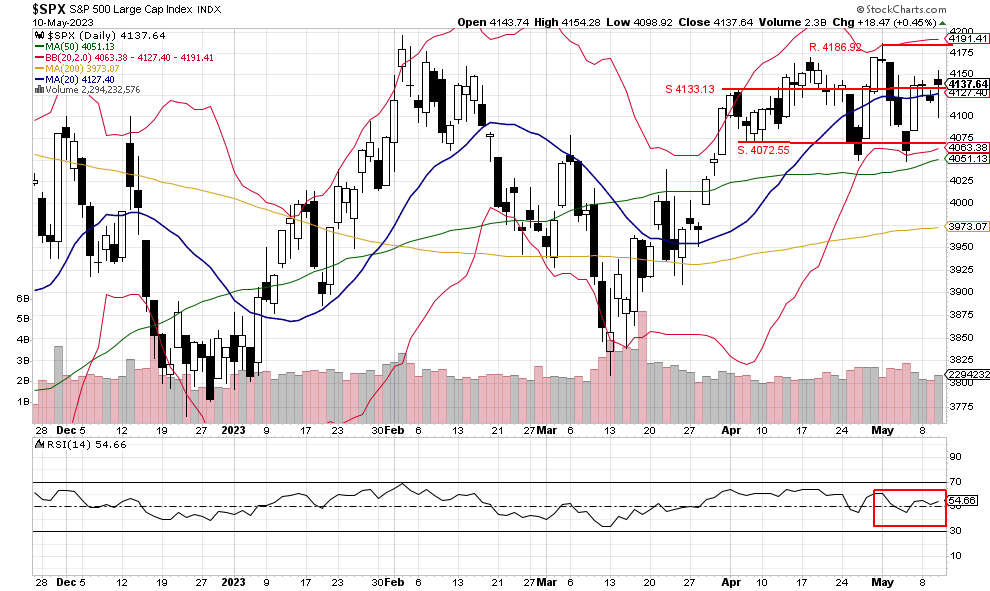Morning Brief

Headline News:
The S&P 500 futures are down 5 points and are trading 0.1% below fair value. The NASDAQ 100 futures are up 11 points and are trading 0.1% above fair value. The Dow Jones Industrial Average futures are down 118 points and are trading 0.3% below fair value. Stock futures are softer this morning.
The NASDAQ 100 futures have outperformed somewhat thanks to pre-market gains in some mega-cap stocks. Concerns about the debt ceiling continue to weigh on sentiment, along with renewed weakness in the regional bank stocks.
Treasury Secretary Yellen issued a fresh warning, saying that a default would be “unthinkable” and that it would undermine the global economy. Former President Trump said in a live town hall hosted by CNN that the GOP should let a default happen if Democrats don’t agree to spending cuts.
The Bank of England voted 7-2 to raise its base rate by 25 bps to 4.50%, as expected. China’s April CPI increased at its slowest yr/yr pace since early 2021, while PPI fell at its fastest rate since 2020, triggering some concerns about the pace of its economic rebound in conjunction with weaker-than-expected new loan data.
Market participants are awaiting the U.S. Producer Price Index for April, along with weekly jobless claims at 8:30 a.m. ET. Treasury yields are moving lower. The 2-yr note yield is down four basis points to 3.87%, and the 10-yr note yield is down four basis points to 3.40%. The U.S. Dollar Index is up 0% to 101.84.
(Michael Gibbs, Managing Director, Lead Portfolio Manager)
Markets:
The S&P 500 closed lower after trading in a wide range but did manage to move above resistance at 4133.13. The RSI index managed to move higher despite the lower close in the S&P 500, which is a positive divergence. The last three trading days have been choppy, but a small base is forming after last Friday’s rally, which has us hopeful there could be another sharp rally soon.
We are currently Intermediate-term bullish and short-term bullish.

John N. Lilly III CPFA
Accredited Portfolio Management Advisor℠
Accredited Asset Management Specialist℠
Portfolio Manager, RJFS
Partner, DJWMG
Windsor Wealth Planners & Strategist
Futures trading is speculative, leveraged, and involves substantial risks. Investing always involves risk, including the loss of principal, and futures trading could present additional risk based on underlying commodities investments.
The Relative Strength Index (RSI), developed by J. Welles Wilder, is a momentum oscillator that measures the speed and changes of price movements.
The advance/decline line (A/D) is a technical indicator that plots the difference between the number of advancing and declining stocks on a daily basis. The indicator is cumulative, with a positive number being added to the prior number, or if the number is negative, it is subtracted from the prior number.
The A/D line is used to show market sentiment, as it tells traders whether there are more stocks rising or falling. It is used to confirm price trends in major indexes and can also warn of reversals when divergence occurs.
The percentage of stocks trading above a specific moving average is a breadth indicator that measures internal strength or weakness in the underlying index. The 50-day moving average is used for short-to-medium-term timeframes, while the 150-day and 200-day moving averages are used for medium-to-long-term timeframes. Signals can be derived from overbought/oversold levels, crosses above/below 50%, and bullish/bearish divergences.
The Dow Jones Industrial Average (DJIA), commonly known as “The Dow,” is an index representing 30 stocks of companies maintained and reviewed by the editors of the Wall Street Journal. The Russell 2000 Index measures the performance of the 2,000 smallest companies in the Russell 3000 Index, which represent approximately 8% of the total market capitalization of the Russell 3000 Index.
The S&P 500 is an unmanaged index of 500 widely held stocks that is generally considered representative of the U.S stock market. Past performance may not be indicative of future results. Keep in mind that individuals cannot invest directly in any index, and index performance does not include transaction costs or other fees, which will affect actual investment performance. Individual investors’ results will vary. Opinions expressed are those of the author John N. Lilly III, and not necessarily those of Raymond James. “There is no guarantee that these statements, opinions, or forecast provided herein will prove to be correct. “The information contained was received from sources believed to be reliable, but accuracy is not guaranteed. Investing always involves risk, and you may incur a profit or loss. No investment strategy can guarantee success. The charts and/or tables presented herein are for illustrative purposes only and should not be considered as the sole basis for your investment decision. International investing involves special risks, including currency fluctuations, different financial accounting standards, and possible political and economic volatility. Investing in emerging markets can be riskier than investing in well-established foreign markets.
This is not a recommendation to buy or sell any company’s stock mentioned above.
US government bonds and treasury bills are guaranteed by the US government and, if held to maturity, offer a fixed rate of return and guaranteed principal value. US government bonds are issued and guaranteed as to the timely payment of principal and interest by the federal government. Bond prices and yields are subject to change based on market conditions and availability. If bonds are sold prior to maturity, you may receive more or less than your initial investment. Holding bonds to term allows redemption at par value. There is an inverse relationship between interest rate movements and bond prices. Generally, when interest rates rise, bond prices fall, and when interest rates fall, bond prices generally rise.
The Nasdaq 100 (^NDX) is a stock market index made up of 103 equity securities issued by 100 of the largest non-financial companies listed on the NASDAQ. It is a modified capitalization-weighted index. It is based on exchange, and it is not an index of U.S.-based companies.



